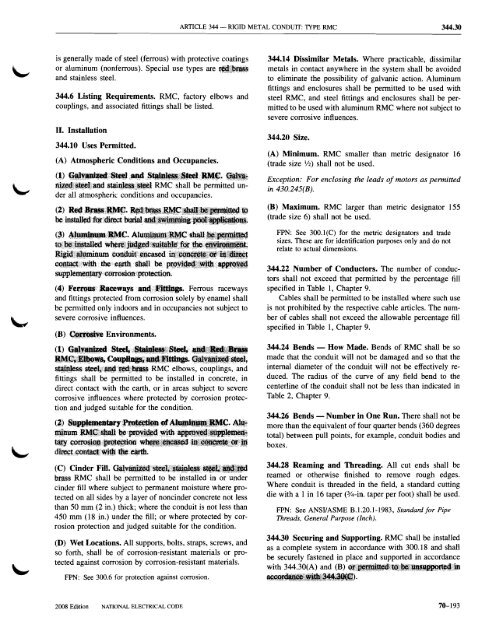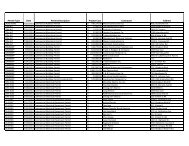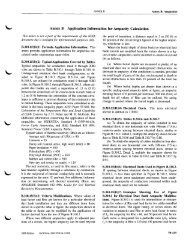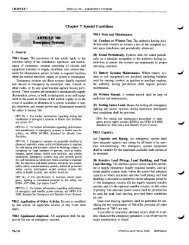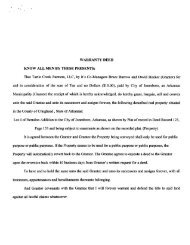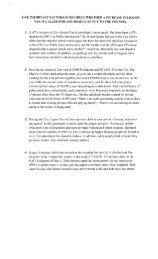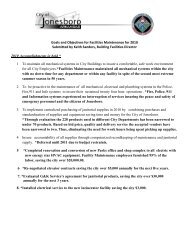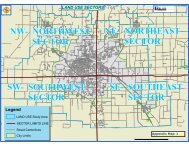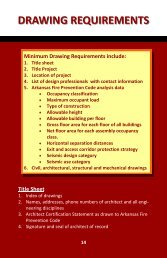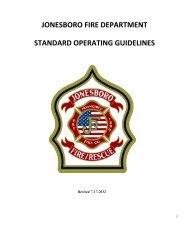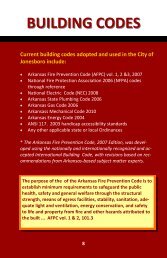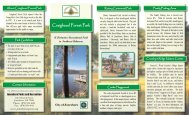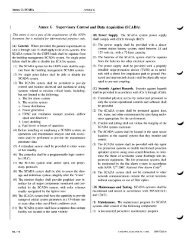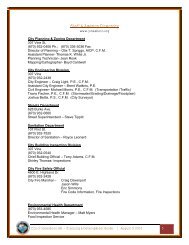Chapter 3 Wiring Methods and Materials
Chapter 3 Wiring Methods and Materials
Chapter 3 Wiring Methods and Materials
You also want an ePaper? Increase the reach of your titles
YUMPU automatically turns print PDFs into web optimized ePapers that Google loves.
ARTICLE 344-RIGID METAL CONDUIT: lYPE RMC<br />
344.30<br />
is generally made of steel (ferrous) with protective coatings<br />
or aluminum (nonferrous). Special use types are ~~M$<br />
<strong>and</strong> stainless steel.<br />
344.6 Listing Requirements. RMC, factory elbows <strong>and</strong><br />
couplings, <strong>and</strong> associated fittings shall be listed.<br />
II. Installation<br />
344.10 Uses Permitted.<br />
(A) Atmospheric Conditions <strong>and</strong> Occupancies.<br />
(1) ~zed' Steel.<strong>and</strong> St.J~;~l~.<br />
naec:l;stul <strong>and</strong> staiIlJess.~ RMC shall be permitted under<br />
all atmospheric conditions <strong>and</strong> occupancies.<br />
(2) Red.BraM.~.~"~.RMC;~::~;~t9<br />
be ~fordirect burial <strong>and</strong>~PU;~.<br />
(3) ~~ RMC. AluuMuJ)J ~CShaU :It!;~~<br />
Rigidalttminum ton(lu.il: encaB1ed<br />
COfl~ with the earth shall be. prp:yi~;}Y~Ut:ap~<br />
supplementary corrosion protection.<br />
(4) Ferrous Raceways <strong>and</strong> -Fittings. Ferrous raceways<br />
<strong>and</strong> fittings protected from corrosion solely by enamel shall<br />
be permitted only indoors <strong>and</strong> in occupancies not subject to<br />
severe corrosive influences.<br />
(B) CO~e Environments.<br />
(1) G~l"a", Steel, ;.....:.$ttIeI, 1t114:!;;MaI!i:....<br />
B,MC~.El"wStCoupIhlKst m:qlJiuu.p. GAl1~._:S.;te~t<br />
s~IesSo steel,; ~ ~;btass RMC elbows, couplings, <strong>and</strong><br />
fittings shall be permitted to be installed in concrete, in<br />
direct contact with the earth, or in areas subject to severe<br />
corrosive influences where protected by corrosion protection<br />
<strong>and</strong> judged suitable for the condition.<br />
(2) SUpplemebtatYPJ:Otecti«),D i)fAJuJ,tdQ.vm.lWC. Al"'~<br />
J;ninum ~Csball be pmyi!ile4 with ~~;~*<br />
d~t.¢Qn_;;~th •• eartb:.<br />
(C) Cinder Fill. Q~!~.d;Si_l~!I~ftlgl~.;~.!;:.lil.<br />
bl'll:ss RMC shall be permitted to be installed in or under<br />
cinder fill where subject to permanent moisture where protected<br />
on all sides by a layer of noncinder concrete not less<br />
than 50 mm (2 in.) thick; where the conduit is not less than<br />
450 mm (18 in.) under the fill; or where protected by corrosion<br />
protection <strong>and</strong> judged suitable for the condition.<br />
(D) Wet Locations. All supports, bolts, straps, screws, <strong>and</strong><br />
so forth, shall be of corrosion-resistant materials or protected<br />
against corrosion by corrosion-resistant materials.<br />
FPN: See 300.6 for protection against corrosion.<br />
344.14 Dissimilar Metals. Where practicable, dissimilar<br />
metals in contact anywhere in the system shall be avoided<br />
to eliminate the possibility of galvanic action. Aluminum<br />
fittings <strong>and</strong> enclosures shall be permitted to be used with<br />
steel RMC, <strong>and</strong> steel fittings <strong>and</strong> enclosures shall be permitted<br />
to be used with aluminum RMC where not subject to<br />
severe corrosive influences.<br />
344.20 Size.<br />
(A) Minimum. RMC smaller than metric designator 16<br />
(trade size V2) shall not be used.<br />
Exception: For enclosing the leads of motors as permitted<br />
in 430. 245(B).<br />
(B) Maximum. RMC larger than metric designator 155<br />
(trade size 6) shall not be used.<br />
FPN: See 300.1(C) for the metric designators <strong>and</strong> trade<br />
sizes. These are for identification purposes only <strong>and</strong> do not<br />
relate to actual dimensions.<br />
344.22 Number of Conductors. The number of conductors<br />
shall not exceed that permitted by the percentage fill<br />
specified in Table 1, <strong>Chapter</strong> 9.<br />
Cables shall be permitted to be installed where such use<br />
is not prohibited by the respective cable articles. The number<br />
of cables shall not exceed the allowable percentage fill<br />
specified in Table 1, <strong>Chapter</strong> 9.<br />
344.24 Bends - How Made. Bends of RMC shall be so<br />
made that the conduit will not be damaged <strong>and</strong> so that the<br />
internal diameter of the conduit will not be effectively reduced.<br />
The radius of the curve of any field bend to the<br />
centerline of the conduit shall not be less than indicated in<br />
Table 2, <strong>Chapter</strong> 9.<br />
344.26 Bends - Number in One Run. There shall not be<br />
more than the equivalent of four quarter bends (360 degrees<br />
total) between pull points, for example, conduit bodies <strong>and</strong><br />
boxes.<br />
344.28 Reaming <strong>and</strong> Threading. All cut ends shall be<br />
reamed or otherwise finished to remove rough edges.<br />
Where conduit is threaded in the field, a st<strong>and</strong>ard cutting<br />
die with a 1 in 16 taper (%-in. taper per foot) shall be used.<br />
FPN: See ANSIIASME 8.1.20.1-1983, St<strong>and</strong>ard for Pipe<br />
Threads, General Purpose (Inch).<br />
344.30 Securing <strong>and</strong> Supporting. RMC shall be installed<br />
as a complete system in accordance with 300.18 <strong>and</strong> shall<br />
be securely fastened in place <strong>and</strong> supported in accordance<br />
with 344.30(A) <strong>and</strong> (B) Q'!i:j~••_i;~il~!ii~~~IIl'~:I.ii.<br />
~itillli~)·<br />
2008 Edition NATIONAL ELECTRICAL CODE<br />
70-193


